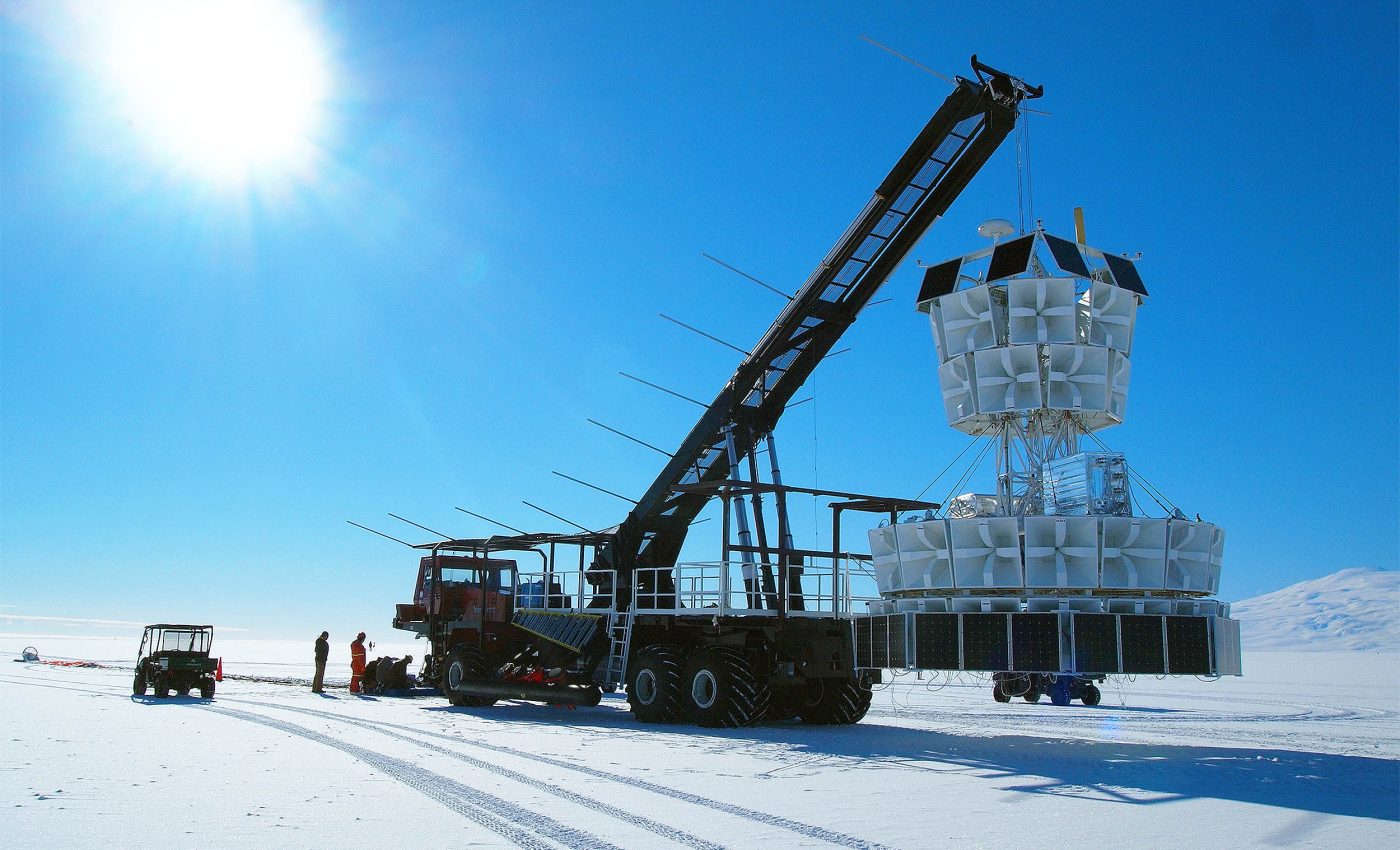
Unknown radio waves coming from deep below the Antarctic ice "defy physics"
Antarctica is home to some of the clearest skies on Earth, and that brutal clarity makes it the perfect place to eavesdrop on the cosmos. Hovering high above the continent, a NASA balloon carries the Antarctic Impulsive Transient Antenna, or ANITA.
The ANITA experiment catches radio murmurs born when ultra-energetic cosmic rays hit the atmosphere.
Most of those pops behave exactly as physicists expect: the signals flip polarity after bouncing off the two-mile-thick ice sheet, a clean mirror image that tells researchers the particle came from above.
But ANITA has also logged a handful of pulses that refuse to flip.
The implication is unsettling because the only way to produce such upward-going radio waves is for a particle to plow straight through the planet, survive more than 3,000 miles of rock, and burst out of the ice on the far side. No known particle should manage that trick.
ANITA finds rule-breaking pulses
Those anomalous pulses arrived at surprisingly steep angles, emerging from about 30° below the horizon instead of the gentle slopes seen in run-of-the-mill cosmic-ray echoes.
The geometry alone flags them as outliers, yet the team verified that the pulses were real and not an instrumental hiccup.
“The radio waves that we detected were at really steep angles, like 30 degrees below the surface of the ice,” said Stephanie Wissel, an associate professor of physics, astronomy and astrophysics who combs the ANITA data for unexpected patterns.
“It’s an interesting problem because we still don’t actually have an explanation for what those anomalies are, but what we do know is that they’re most likely not representing neutrinos.”
Helping ANITA filter cosmic chatter
Separating genuine particle signatures from noise takes painstaking effort. Researchers replay thousands of hours of balloon data through computer models that mimic the detector’s response to lightning, satellite transmissions, and even the crackle of auroras.
By comparing those simulations with real events, they can cull anything that lacks the hallmark shape of a particle-induced shower.
The ANITA collaboration also leans on cross-checks with ground networks such as IceCube and the Pierre Auger Observatory. If a pulse appears only in the balloon logs and nowhere else, it goes under the microscope.
The handful of strange upward events survived every filter the scientists could devise, reinforcing the sense that something unfamiliar is in play.
Ghostly nature of neutrinos
The obvious culprits would be neutrinos, the universe’s most elusive messengers. These chargeless wisps hardly ever collide with matter, making them perfect probes of distant cataclysms, yet fiendishly hard to spot.
“You have a billion neutrinos passing through your thumbnail at any moment, but neutrinos don’t really interact,” she said.
“So, this is the double-edged sword problem. If we detect them, it means they have traveled all this way without interacting with anything else. We could be detecting a neutrino coming from the edge of the observable universe.”
Listening from 25 miles up
“We use radio detectors to try to build really, really large neutrino telescopes so that we can go after a pretty low expected event rate,” Wissel explained.
ANITA tackles that challenge by floating roughly 25 miles above the snow, a perch that expands each antenna’s footprint to hundreds of square miles without planting a single pole in the ice.
“We have these radio antennas on a balloon that flies 40 kilometers above the ice in Antarctica,” Wissel said. “We point our antennas down at the ice and look for neutrinos that interact in the ice, producing radio emissions that we can then sense with our detectors.”
Why does any of this matter?
When the team traced the weird signals backward, the flight paths pointed through Earth’s interior, defying the standard model of particle physics.
Additional searches in data from the IceCube and Auger neutrino detectors turned up no counterpart events, trimming the roster of ordinary explanations.
“My guess is that some interesting radio propagation effect occurs near ice and also near the horizon that I don’t fully understand, but we certainly explored several of those, and we haven’t been able to find any of those yet either,” Wissel said.
Hoping that PUEO can help
The next balloon in the series is the Payload for Ultrahigh Energy Observations, or PUEO, set for its first Antarctic voyage in December 2025.
It will carry more antennas and faster electronics, improving sensitivity by at least a factor of five over ANITA.
“So, right now, it’s one of these long-standing mysteries, and I’m excited that when we fly PUEO, we’ll have better sensitivity,” Wissel concluded.
“In principle, we should pick up more anomalies, and maybe we’ll actually understand what they are. We also might detect neutrinos, which would in some ways be a lot more exciting.”
What happens next?
Elsewhere, instruments buried deep in ice, anchored to the seafloor, or orbiting aboard satellites are racking up their own successes.
In February 2025 a detector beneath the Pacific seafloor logged the most energetic neutrino ever observed, underscoring how quickly the discipline is advancing.
Whether ANITA’s anomalies prove to be exotic particles or a quirk of radio propagation, upcoming missions promise fresh clues. Until then, we will all have to wait and wonder.
The full study was published in the journal Physical Review Letters.
—–
Like what you read? Subscribe to our newsletter for engaging articles, exclusive content, and the latest updates.
Check us out on EarthSnap, a free app brought to you by Eric Ralls and Earth.com.
—–













